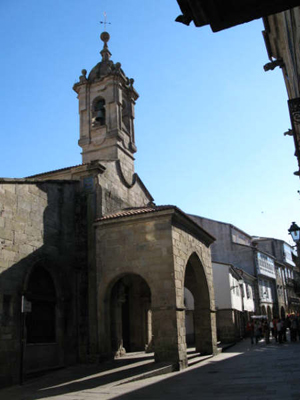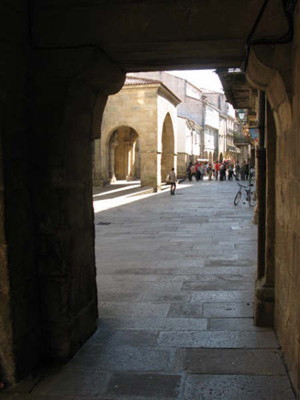 |
||||||||||
 |
||||||||||
|
1517: Santa María Salomé, Santiago de Compostela, Galicia, Spain Mystery Worshipper: Augustine the Aleut. The church: Santa María Salomé, Santiago de Compostela, Galicia, Spain. Denomination: Roman Catholic, Archdiocese of Santiago de Compostela. The building: The exquisite Romanesque doorway and pale yellow exterior stone walls date from the 12th century, with a Gothic porch added in the 15th century. A baroque tower dates from the 18th century. The interior is generally 14th century, its original beauty having been camouflaged to a great degree by whitewash. There is the usual baroque retablo behind the main altar and some interesting statuary, including deliciously grotesque gargoyles. I headed to a spartan side chapel with a plain crucifix behind the altar. If you check out the left nave, two of the 17th century angels wear spectacles the artists were having their fun that day. The church: This is the only church in Spain dedicated to the mother of St James, St Mary Salome, who some scholars think was a sister of the Blessed Virgin and thus Jesus' aunt. The Gospels tell us that she was a witness to the crucifixion and was present at Jesus' tomb on the third day. The neighbourhood: A tomb allegedly that of St James the apostle was discovered here in the early ninth century by a hermit who was attracted to the site by a vision of stars – hence the appellation Compostela, or field of stars. But Santiago is said to be the wettest major city in Spain, and the epithet el orinal de España – the urinal of Spain – is also applied. The Rúa del Villar in the rain is one of the archetypal scenes of Santiago. The church is in the old city, just on the border of the tourist-ridden zone and a residential area. At 7.00 in the morning the streets were devoid of life aside from diligent street cleaners preparing the city for its day ahead. The cast: The priest was in his 30s, with very short hair and beard, looking a bit like a young Ignatius Loyola, but I have no idea of his name. The date & time: Monday, 22 October 2007, 7.00am. What was the name of the service? Morning Mass. How full was the building? The side chapel could hold about 30 at a pinch. There were half a dozen older women, two older men, all with rosaries, two men in their 30s wearing workers' overalls, a Spanish pilgrim, and myself. The nave could fit about 100 or so. Did anyone welcome you personally? There were the customary polite but curious nods of welcome as I took my seat and joined the usual gang of suspects. Was your pew comfortable? The side chapel had wicker and wooden chairs with unpadded kneelers. I wouldn't have wanted to spend my day there, but it would be all right for a half hour. How would you describe the pre-service atmosphere? Very hushed, and one felt that nobody believed that they should be awake hours before the rest of Galicia, and without their morning coffee. It was still dark outside – the sun had not yet risen. What were the exact opening words of the service? I'm guessing that it was the usual opening invocation of the Trinity, but as it was in Galician, the local language (sort of halfway between Portuguese and Castilian Spanish – but never, never say so out loud!) and I was late, I cannot be 100 percent certain. What books did the congregation use during the service? There were prayer cards in the pews, but nothing else. What musical instruments were played? None, not even the famed bagpipes of Galicia. Did anything distract you? It took me a minute or two to realize that the mass was not in Castilian, which by then I could almost, kind-of, follow. Then my eyes alighted on the other pilgrim, a striking young Spanish woman, whom I tried not to notice as I followed the service. (I'll have more to say about her in a moment.) Was the worship stiff-upper-lip, happy clappy, or what? Very quiet, almost as if the priest felt that we were all hung over and should not be startled by the noise. After he read the Gospel in Galician, he turned to the Spaniard and to me and asked, ¿Castellano? She nodded, and so he read the gospel a second time in Castilian. The others went up to receive communion, but the Spaniard and myself held back. He asked in Castilian Spanish if we were pilgrims (as if it were not obvious from our tans, haggard leanness and very unpressed clothing), and signalled us to come up; the others stood by us, and he recited the traditional pilgrims' blessing for us. After he finished the ablutions, he noticed that one of the two men in overalls seemed distressed and on the verge of weeping, and so he went and sat by him for a minute, speaking to him quietly.  Exactly how long was the sermon? No sermon this morning. After all, none of us had taken our morning coffee yet. Which part of the service was like being in heaven? The intimacy, the quiet, and the priest's careful attention to the dozen of us there, as individuals. And which part was like being in... er... the other place? Nothing, absolutely nothing. This was perfect. This was the end of almost 50 days and 1200 kilometres. It was time to go home. What happened when you hung around after the service looking lost? Everyone cleared out very quickly, the priest scampering to the sacristy, mice scattering at his approach, the workers off to their jobs, and the old ladies to their days. I fell into company with the young Spanish woman, a graduate researcher in biology from a left-wing family and, in the politics of Spain (for, in Spain, politics and church are never separate), definitely not a churchgoer. Her boyfriend of eight years had left her, and she had taken a fortnight's walking to Santiago for a break and to think about the next bit of her life. On her last morning in Santiago, she had been driven from her hostel by snoring and had hours to kill before her bus left for Salamanca. Seeing the light, she had entered the chapel, wondering why she was doing something so odd. I walked her to the bus station. How would you describe the after-service coffee? At 8.00am this was not easily found, but a hole-in-the-wall bar provided a fine café con leche, and the waiter gave us a small bottle of orújo, the local firewater, to flavour the coffee. We should try this back home, I thought. How would you feel about making this church your regular (where 10 = ecstatic, 0 = terminal)? 10 – There was something wonderful about this little side chapel – I would come back all the time if I were in Santiago. Why, I might even walk 1000 kilometres to get there. Did the service make you feel glad to be a Christian? Like the man said, we were all broken and coming for healing. This was the place. What one thing will you remember about all this in seven days' time? My blisters, the people I had met, and what a strange and extraordinary place this is. More Camino reports |
|
|
||||||||||||||||||||||||||||||||||||
| More Mystery Worshipper reports | |||||||||||||||||||||||||||||||||||||||
 |
|||||||||||||||||||||||||||||||||||||||






